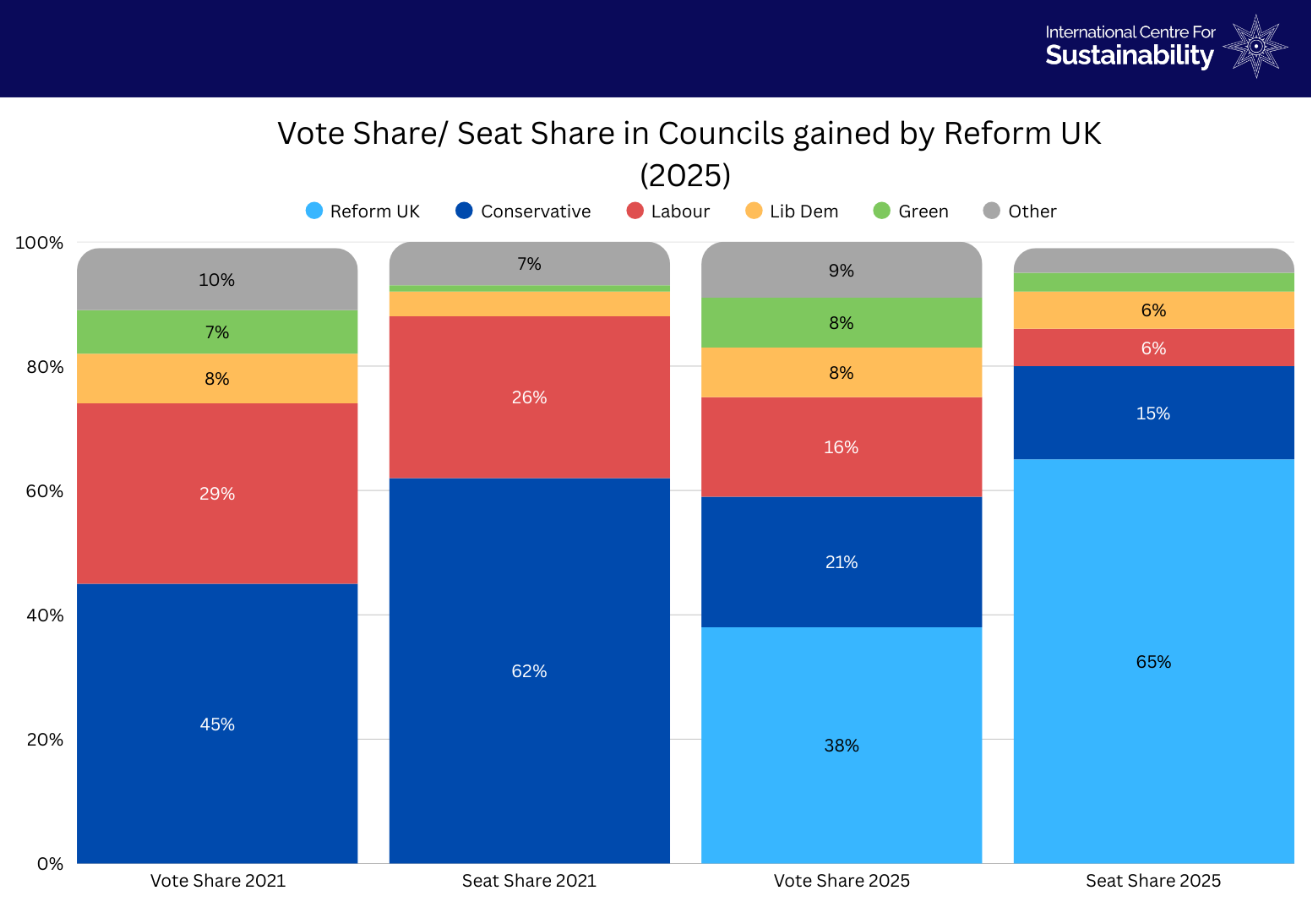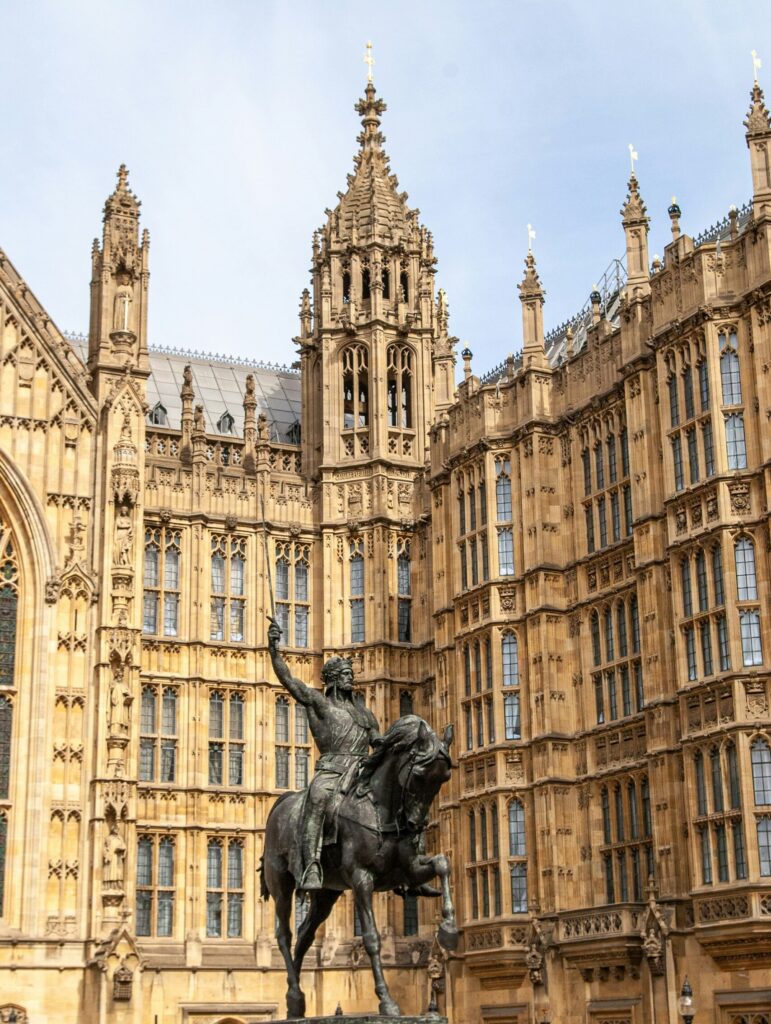Authors: Pravar Petkar, Head of Strengthening Democracy Desk; Amy Wonnacott, Research Intern
The results of the May 2025 local elections in England caught the eye within hours of being announced. This is in no small part because of the 677 seats gained by Reform UK, which at the last set of elections in 2021 held no local council seats at all. A close analysis of the available data reveals that whilst Reform UK and the Liberal Democrats made some significant gains, both parties disproportionately benefited from the First-Past-the-Post electoral system. These results, viewed in context, should open up conversations around electoral reform towards more proportional representation at both local and national level.
Table 1 displays the total vote and seat share for each party, based on available data.
Total Council Data: 2025 | |||
Party | Total Seats Won | Vote Share | Seat Share |
Reform UK | 677 | 32.3% | 45.9% |
Liberal Democrats | 370 | 15.5% | 21.3% |
Conservative | 319 | 21.7% | 16.8% |
Labour | 98 | 14.7% | 6.4% |
Green | 79 | 9.0% | 5.4% |
Table 1: total seats won, vote share and seat share in the May 2025 council elections. As of 8 May 2025, vote share data was missing for Cornwall County Council.
First-Past-the-Post favoured Reform UK and the Liberal Democrats
The First-Past-the-Post electoral system was used across all the mayoral and council elections that took place in May 2025. For the Cambridgeshire & Peterborough, Doncaster, North Tyneside and West of England mayoralties, this marks a shift from the Supplementary Vote system used in 2021. Under the Supplementary Vote, voters can choose a first preference candidate and a second preference candidate from another party; under First-Past-the-Post, they have only one option. Across 22 of the 23 councils contested, both Reform UK and the Liberal Democrats won a greater share of seats (45.9% and 21.3%) than their respective vote shares (32.3% and 15.5%). Labour, by contrast won a much lower seat share (6.4%) than its vote share (14.7%), which nevertheless was only the fourth highest amongst England’s major parties.
Figure 1: vote share and seat share for the 2025 council elections, for the five main parties. Data from Cornwall County Council was not available as of 8 May 2025.
Some council results saw significantly disproportionate advantages or disadvantages for specific parties, as detailed in Table 2.
Council | Party | Vote Share | Seat Share |
Cambridgeshire | Liberal Democrats | 27.4% | 50.8% |
Doncaster | Reform UK | 36.2% | 67.3% |
Durham | Labour | 20.9% | 4.1% |
Gloucestershire | Liberal Democrats | 27.2% | 49.1% |
Kent | Reform | 37.0% | 70.4% |
North Northamptonshire | Labour | 17.0% | 1.0% |
Oxfordshire | Reform | 17.8% | 1.0% |
Staffordshire | Reform | 41.0% | 79.0% |
Table 2: a selection of council results where vote share and seat share were significantly disproportionate.
These figures highlight how the First-Past-the-Post electoral system can produce significantly disproportional outcomes in specific areas. This is typically because of the uneven distribution of votes for any given party across the wards that make up each council area. Sam Freedman highlights that under the First-Past-the-Post system, there is a ‘tipping point’ where vote share produces a disproportionately greater seat share. The available data from the 2025 local elections suggests that the ‘tipping point’ was around 27%. This is shown from the results in Cambridgeshire and Gloucestershire identified in Table 2, as well as the results from Northumberland. There, Reform UK won 33.3% of the seats on 29.3% of the votes, the Conservatives won 37.7% of the seats on 28.9% of the votes and Labour only 11.6% of the seats on 22.3% of the votes. With a more proportional electoral system, we would expect to see Reform UK and the Conservatives winning an almost identical number of seats, with Labour slightly further behind; under First-Past-the-Post, the Conservatives won 26 seats of the available 69, Reform UK won 23 and Labour only 8. In these elections, it appears that just over a quarter of the vote is sufficient for a party to secure a disproportionately greater seat share.
Reform UK gained votes from both the Conservatives and Labour
Reform UK gained overall control of 10 out of the 23 councils where elections were held. A comparison between the 2025 vote and seat shares in these councils and the equivalent data from the 2021 elections suggests that Reform UK’s gains have largely been at the expense of the Conservatives, and to a lesser extent from Labour. As seen from Figure 2, the Conservatives’ vote share considerably fell from 2021 to 2025 in these 10 council areas. The scale of the Conservatives’ losses are not enough to account for all of Reform UK’s gains in these areas. As a result, these gains are likely down to ‘new’ voters (who did not vote at all in the 2021 elections) and losses from Labour to Reform UK. The changes in seat share – from 62% to 15% for the Conservatives, and 26% to 5% for Labour – are exacerbated by the unpredictability of the First-Past-the-Post electoral system, as highlighted above. These shifts reinforce the fragmented multi-party picture of British democracy that emerged from the 2024 General Election.
Figure 2: vote share and seat share for each of the five main parties in councils where Reform gained overall control in 2025, with the equivalent figures from the 2021 elections for each party.
Proportionality must be viewed in the context of turnout
The results of these local elections must also be viewed in the context of the turnout. The average turnout (from the 11 councils where data is available as of 8 May 2025) was 33.7%. This means that in the councils where Reform UK gained overall control, it won 65% of the seats from only around 13% of registered voters actually having voted for it. Available data from LG Inform highlights that average turnout in local elections since 2015 has been consistently between 30% and 35%. Turnout at the 2024 General Election, by contrast, was 59%. As a result, there is a need for caution before extrapolating too far from the local election results to Westminster constituency results in a General Election. Nevertheless, attention to the turnout figures further highlights that the First-Past-the-Post system, as it stands, can hand parties significant power with the support of only a small proportion of the electorate.
A conversation on proportional representation must begin
The disproportionality of the results is further illustrated when looking at the Gallagher Index – calculated as a measure of vote share received by a political party compared to the number of seats won. A higher Gallagher Index score (up to 100) indicates greater disproportionality.
Gallagher Index of Vote Share / Seat Share | |
All councils contested in 2025 elections | 12.68 |
Councils in 2021 where Reform UK gained overall control in 2025 | 13.06 |
Councils in 2025 where Reform UK gained overall control | 21.48 |
Councils with no overall majority contested in 2025 elections | 8.22 |
Table 3: Gallagher Index scores relating to 2025 local elections.
These results show that where Reform UK was victorious in the 2025 local elections, it was on the basis of highly disproportionate results. The trend of disproportionality is not limited to local elections. The Gallagher Index score for the 2024 General Election was 23.6 – the fifth highest in the world. Although the figure for the 2025 local elections is not as high, it still indicates that the current electoral system does not produce representative results.
These results ought to prompt a serious conversation around electoral reform. Taken together, the 2024 General Election and the 2025 local elections highlight the unsuitability of First-Past-the-Post in an increasingly multiparty democratic system. This is not only down to the disparity between vote and seat share in both contests, but the way in which the system incentivises parties to concentrate their votes in marginal constituencies or wards where victory is most likely. A more proportional system, such as the Single Transferrable Vote System (PR-STV) would help to ensure greater balance between parties at local level. Under PR-STV, voters can rank all the candidates on the ballot paper – or as many as they choose – according to their preference. Constituencies would be larger, with multiple members, and seats would be apportioned according to the proportion of the votes cast based on the preferences expressed. This would make voters’ choice in local elections more meaningful, as no vote is ‘wasted’.
However, the trade-offs of such a system require close consideration too. At local council level, this is likely to lead to more councils where no single party has overall control. In some areas, this can encourage cooperation, whilst in others, it leads to what the Local Government Information Unit has termed “political jostling”. As a result, there may be some trade-offs to a more proportional system at a time when councils will have an important role to play in ensuring the delivery of basic public services through clear decision-making.
In respect of Westminster, modelling by Ben Ansell suggests that proportional representation (on current national vote share estimates, and assuming a Uniform National Swing) would result in either a Reform-Conservative minority government, or a coalition comprised of Labour, the Liberal Democrats, the Greens, the Scottish National Party (SNP) and Plaid Cymru. There is a degree of instability with any minority government, whilst a broad coalition involving parties from the UK’s devolved territories will have to manage tensions relating to the extent of devolved competence, or, in the case of the secession. The make-up of such a coalition may mean that it is more unstable than in a unitary state such as the Netherlands, where the whole country is treated as one constituency such that there is no local representation at parliamentary level.
The results of the 2025 local elections further expose the weaknesses of the First-Past-the-Post electoral system. A stronger British democracy requires us to think seriously about how our elections operate going forward.





